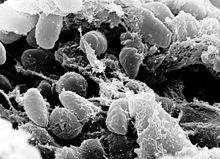
Back طاعون رئوي Arabic طاعون رئوى ARZ Pesta pneumònica Catalan Plicní mor Czech Peste pulmonar Spanish Peste pneumonique French Plá niúmóineach Irish 폐페스트 Korean Longpest Dutch Lungepest NN
| Pneumonic plague | |
|---|---|
 | |
| A scanning electron micrograph depicting a mass of Yersinia pestis bacteria | |
| Specialty | Infectious disease |
| Symptoms | Fever, headache, shortness of breath, cough, hemoptysis[1] |
| Usual onset | 3 to 7 days[2] |
| Causes | Yersinia pestis[3] |
| Risk factors | Rodents[3] |
| Diagnostic method | Sputum testing[1] |
| Treatment | Antibiotics[1] |
| Prognosis | A case-fatality ratio of 30% to 60% for the bubonic type, and invariably fatal for the pneumonic kind when left untreated.[4] |
| Frequency | Rare[2] |
Pneumonic plague is a severe lung infection caused by the bacterium Yersinia pestis.[3] Symptoms include fever, headache, shortness of breath, chest pain, and coughing.[1] They typically start about three to seven days after exposure.[2] It is one of three forms of plague, the other two being septicemic plague and bubonic plague.[3]
The pneumonic form may occur following an initial bubonic or septicemic plague infection.[3] It may also result from breathing in airborne droplets from another person or animal infected with pneumonic plague.[1] The difference between the forms of plague is the location of infection; in pneumonic plague the infection is in the lungs, in bubonic plague the lymph nodes, and in septicemic plague within the blood.[3] Diagnosis is by testing the blood, sputum, or fluid from a lymph node.[1]
While vaccines are being developed, in most countries they are not yet commercially available.[1][3] Prevention is by avoiding contact with infected rodents, people, or cats.[1][3] It is recommended that those infected be isolated from others.[2] Treatment of pneumonic plague is with antibiotics.[1]
Plague is present among rodents in Africa, the Americas, and Asia.[3] Pneumonic plague is more serious and less common than bubonic plague.[1] The total reported number of cases of all types of plague in 2013 was 783.[2] Left untreated, pneumonic plague is always fatal.[3] Some hypothesize that the pneumonic version of the plague was mainly responsible for the Black Death that resulted in approximately 75 - 200 million deaths in the 1300s.[2][5]
- ^ a b c d e f g h i j "FAQ Plague". www.cdc.gov. Archived from the original on 14 March 2017. Retrieved 13 March 2017.
- ^ a b c d e f "Plague". World Health Organization. September 2016. Archived from the original on 24 April 2015. Retrieved 14 March 2017.
- ^ a b c d e f g h i j "Plague". www.who.int. Archived from the original on 19 March 2017. Retrieved 14 March 2017.
- ^ who, who. "plague". who.int. WHO. Retrieved 23 June 2022.
- ^ McCoy, Terrence (31 March 2014). "Everything you know about the Black Death is wrong". Washington Post. The Washington Post. Archived from the original on 27 August 2016. Retrieved 14 March 2017.
© MMXXIII Rich X Search. We shall prevail. All rights reserved. Rich X Search